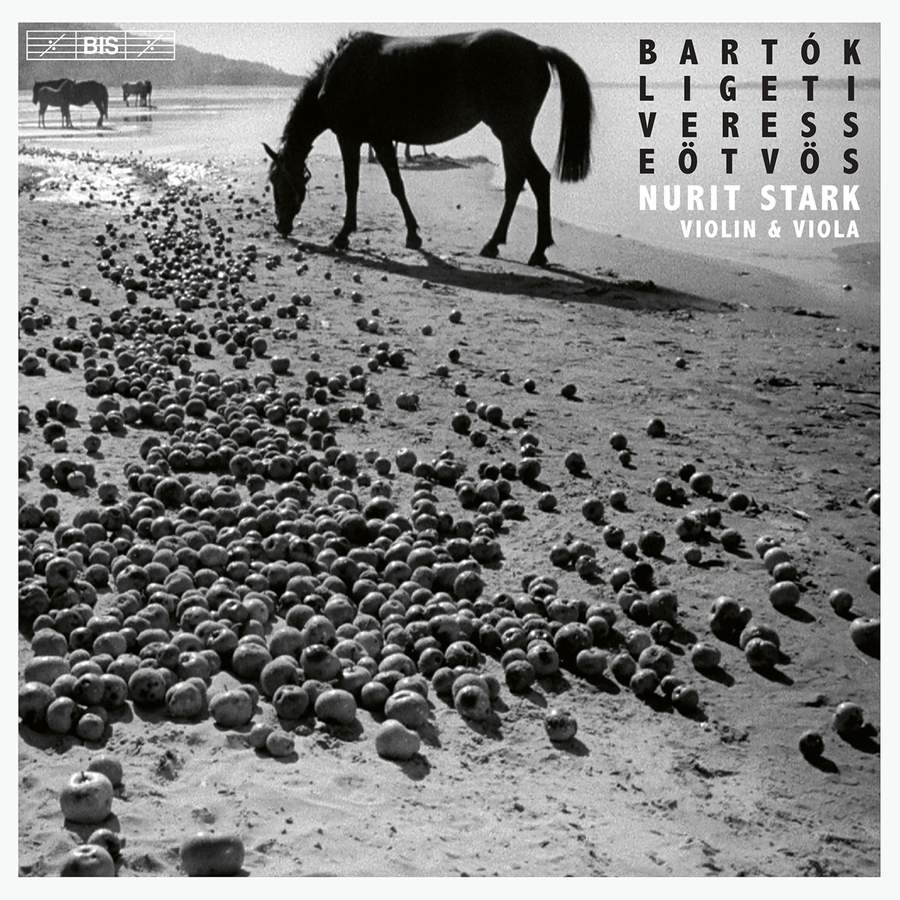Nurit Stark: Bartók, Ligeti, Veress, Eötvös
View record and artist detailsRecord and Artist Details
Genre:
Instrumental
Label: BIS
Magazine Review Date: 10/2022
Media Format: Super Audio CD
Media Runtime: 79
Mastering:
DDD
Catalogue Number: BIS2416

Tracks:
| Composition | Artist Credit |
|---|---|
| Sonata for Solo Violin |
Béla Bartók, Composer
Nurit Stark, Violin |
| Sonata for Viola |
György Ligeti, Composer
Nurit Stark, Violin |
| Sonata for Violin |
Sándor Veress, Composer
Nurit Stark, Violin |
| Adventures of the Dominant Seventh Chord |
Peter Eötvös, Composer
Nurit Stark, Violin |
Author: Rob Cowan
The supremely gifted Israeli violinist/viola player Nurit Stark has a passion for contemporary music and her command of tonal colour, rhythm, violinistic effects and imaginative interpretation illuminates virtually everything she plays. In the context of this all-Hungarian programme, the earliest selection – Sándor Veress’s 1935 Sonata for solo violin – takes on aspects of genuine Hungarian folk music, with saucy glissandos and colouristic pizzicatos in the first movement, an improvisatory central outburst in the second and wildly dancing inflections in the third. The closing piece, Peter Eötvös’s Adventures of the Dominant Seventh Chord (2019, dedicated to Stark), is also the most recent and possibly the most varied stylistically. The chord itself remains unresolved but instead faces folkish atonal material for a number of nourishing collisions. And is that a side glance in the direction of Kodály’s Solo Cello Sonata that I hear at 2'46"? Maybe … or maybe, in musical terms, just a whiff of local flora.
In Bartók’s Solo Sonata (1944) – surely the programme’s undisputed masterpiece – the Tempo di ciaconna’s opening chords are elongated and knitted together in a sort of ironed-out legato rather than attacked separately as is so often the case (and as is suggested on the printed page). I’d recently been listening to the excellent György Pauk (Naxos, 5/96) and Tibor Varga’s white-hot 1962 recording of the piece (DG, in the label’s ‘111 – The Violin: Legendary Recordings’ box) and the difference is striking. The more recently recorded Frank Peter Zimmermann (BIS, 1/21) takes a route that’s similar to both Pauk and Varga. Nurit Stark’s dynamics are wide-ranging, while her ascent to the stratosphere sounds smooth and effortless. She captures, even relishes the harmonic boldness of Bartók’s writing, playing with a full body of tone yet without a hint of aggression, before quietly sloping off for the movement’s close. The ‘Fuga’ initially admits an element of vibrato that was missing from the first movement; Stark’s approach is both free and suavely expressive, though the part-writing is clear, working towards a brief but telling elevation and a clinching final strike. The Adagio ‘Melodia’ is blanched, initially at least, a lonely shepherd singing from a distant field perhaps, the journey from note to note witnessing bends in the line, not quite portamentos but almost, whereas the buzzing finale twitches this way and that, Stark’s approach rhythmically assertive and texturally cutting, before she quietly walks away and finishes off with an energetic flourish.
It’s an extremely interesting performance but I prefer the vibrancy and directness of Pauk, Varga and Zimmermann, not to mention the work’s dedicatee, Yehudi Menuhin (preferably his first recording – Warner). Regarding Ligeti’s Solo Viola Sonata (1991-94), annotator Giovanni Bietti is careful to point out that in the first movement, which is played only on the low C string, purposely altered intonations on certain notes ‘are not the player’s mistakes’. In ‘Loop’, which is made up of gravel-kicking, rhythmically driven repeated chords gaining in intensity, Stark’s mastery of the instrument is vividly demonstrated. Next comes an achingly elegiac ‘Facsar’, which starts out by mirroring Baroque manners then becomes freer as it progresses, whereas in the following Prestissimo con sordino, such is Stark’s virtuosity that you could swear you were listening to duetting violists playing a chordal étude at speed. ‘Lamento’ is a study in contrasts, harsh chords and whispering asides, while mirror images of early music return for the closing Chaconne chromatique (the work’s most instantly appealing movement), which ends with, as Bietti suggests, an allusion to tonal harmony.
So quite a journey, one that’s profoundly representative of the Hungarian musical psyche in the 20th century and which is served by a musician whose talents certainly qualify her for the job of performing it. Only in the Bartók would I check Stark’s highly individual reading against those of her finest rivals, merely for the sake of gauging how best you like the music served. I admire her performance but wouldn’t want it as a sole library choice. The sound is strikingly lifelike.
Explore the world’s largest classical music catalogue on Apple Music Classical.
Included with an Apple Music subscription. Download now.

Gramophone Digital Club
- Digital Edition
- Digital Archive
- Reviews Database
- Events & Offers
From £9.20 / month
Subscribe
Gramophone Club
- Print Edition
- Digital Edition
- Digital Archive
- Reviews Database
- Events & Offers
From £11.45 / month
Subscribe
If you are a library, university or other organisation that would be interested in an institutional subscription to Gramophone please click here for further information.






